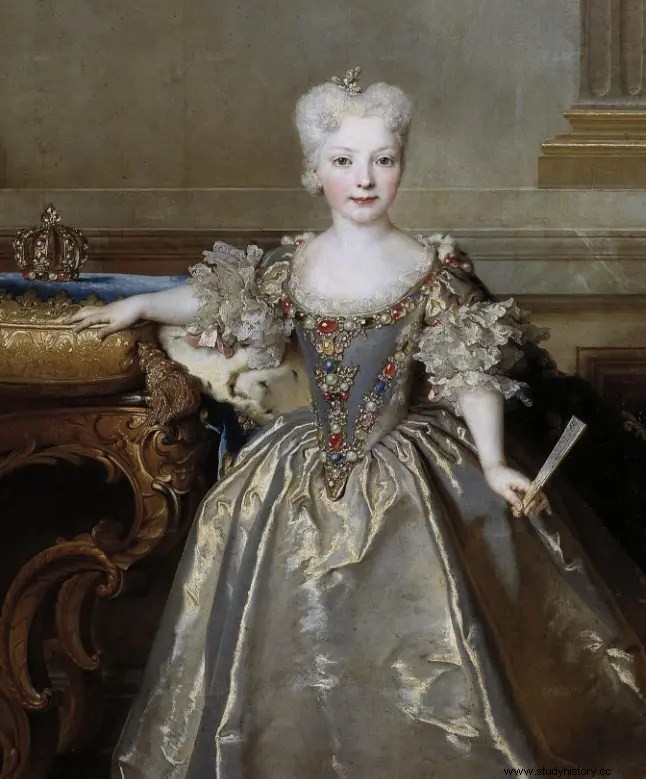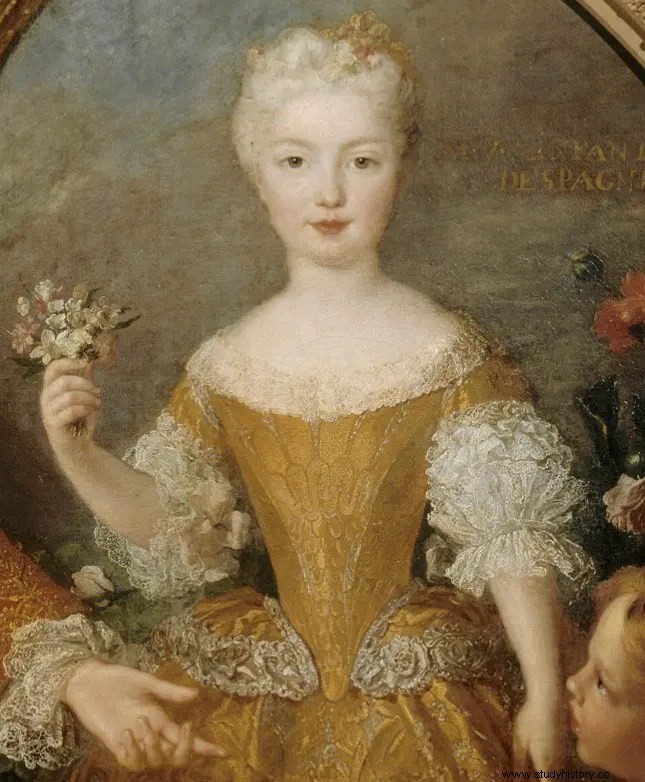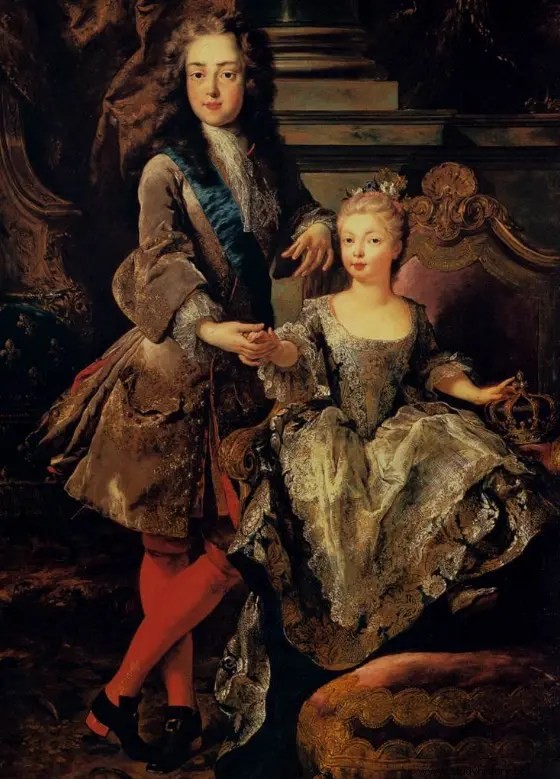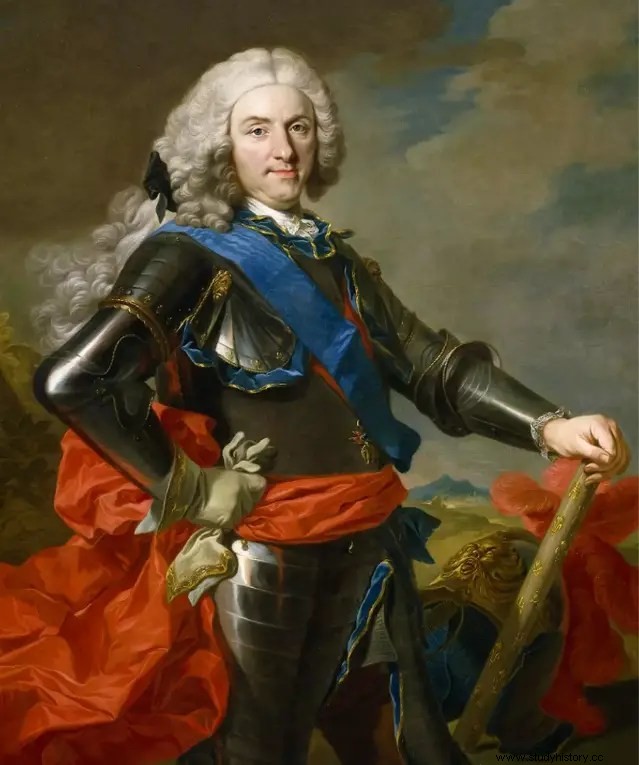During the year 1719, relations between France and Spain were not looking good. Philip V, grandson of the Sun King, reigns over the people of Madrid jointly with his second wife Elisabeth Farnese. Philippe d'Orleans , Regent of France, governs for the young Louis XV. Bourbon and Orléans, one family!
However, the two crowns have just engaged in a fratricidal war :France did not support Spain in its desire to reconquer its lost provinces in Italy. This aggressive policy led by Spain has been disastrous , even if it allowed the ambitious Elisabeth Farnese to ensure for the future, for one of her sons, the duchies of Parma, Piacenza and Guastalla.
In 1720, France and Spain were keen to strengthen ties. Cardinal Dubois , then gray eminence of the Regent Philippe of Orléans, thinks of a double union which will seal for good the alliance between the two Bourbon thrones.
Children as a pledge of peace
The plan is simple:send one of the Regent's daughters, Louise-Elisabeth d'Orléans, to Madrid. , known as Mademoiselle de Montpensier, to unite her to Louis, Prince of Asturias and heir to the throne of Spain, son of Philip V and his first wife Marie-Louise de Savoie . Louis' half-sister, the Infanta Marie-Anne-Victoire , daughter of Elisabeth Farnese, would be sent to France to marry Louis XV.
Dubois then uses good old corruption tactics to convince the impenetrable Philip V. He approaches Father Daubenton, the King's confessor whom he knows is very influential and with whom he maintains close relations, so that the sovereign feels that the idea emanates from him. To leave nothing to chance, Dubois offers Secretary of State José Grimaldo's wife irresistible jewelry !
It probably didn't take much to convince Philip V, still in love with the France in which he grew up:July 26, 1721 , the envoy of the Court of France in Madrid is summoned to the Royal Palace, and is presented by the King with the proposal of a double marriage! Detail:the promises are all very young. But at that time, age did not hinder matrimonial negotiations...
Louis, Prince of Asturias, from the height of his 14 years old , is the oldest. The Regent's daughter is 12 , Louis XV 11 years old , and Marie-Anne his future fiancée has only 3 springs ! Whatever. The King of Spain is delighted with this rapprochement with the homeland of his childhood , which will allow her son to perpetuate the line and her daughter to become Queen of France. As for the Regent, he already sees his Louise-Elisabeth Queen of Spain.

Louis XV is not consulted
Small flat, Louis XV is not yet aware. He is young, but he is the King. All the same. All fearing the monarch's reaction, easily irritated, extremely sensitive and capable of wallowing in an ominous silence at the slightest annoyance.
On September 14, 1721, in the presence of Cardinal Dubois, his tutor Fleury, the superintendent of the King's education the Duke of Bourbon and Marshal de Villeroy, the Regent announced the news to Louis XV. The young monarch, all red, confronted with a fait accompli, remains silent while big tears roll down her cheeks.
It takes all the gentleness and patience of Fleury , the only one able to reassure the sovereign, so that Louis XV decides to go to the Council to officially announce his marriage. The decision is ratified and the news immediately communicated to the people, despite the age of the young bride, which postpones to a distant future (eight or ten years) the prospect of an effective marriage and heirs to the throne.
A very long delay, which left the door open for many adventures.
Leaving the young monarch some time to recover from his emotions, the Regent did not ask him for permission to marry his own daughter with the Prince of Asturias two weeks later:granted.
A 3-year-old doll
Extraordinary embassies giving rise to splendid festivities are sent to France and Spain for official requests, and marriage contracts are finalized.
Finally, it was in January 1722 that the exchange of princesses took place. . Spanning the Bidassoa, which marks the boundary between France and Spain, a wooden pavilion has been erected on the island of Pheasants. Louise-Elisabeth bids farewell to France while little Marie-Anne leaves the arms of her governess crying all the tears in her body. It is the custom:the bride, whatever her age, is sent to the country of her future husband. To be familiar with your new homeland, they say...
The little one recovers quickly from this sudden change. Extremely awake , she was brought up very well. She smiles and waves her hands in front of the cheers of the population, which are numerous in each city crossed.
It's in March, in Bourg-la-Reine , that Louis XV meets his bride for the first time. He comes out of his silence to give her a gift in keeping with her young age:a doll worth 20,000 pounds! He now accompanies her to Paris:it is at the Louvre that Marie-Anne settles, celebrated by the Parisians.

Shows and other entertainment follow one another in the capital for several days in honor of the one who is henceforth called the Infanta-Queen . Even if many think that this engagement imposed on a young monarch is very premature, all the courtiers are under the spell of this exquisite three-year-old child, little princess "very pretty, very lively and full of little graces .
Madame Palatine bears witness to the precocity of this treasure, which makes “reflections that would be worthy of a person of thirty years ". In short, she already shows herself worthy of her future profession as Queen. There is no shortage of anecdotes that prove it, such as this particularly stifling summer evening. We hasten to dismiss the curious who watch her eat. She then exclaims, "It's hot, but I'd rather have this pain and let all my people see me ". Princess Palatine is delighted with the presence of this charming princess, whom she will court five weeks after arrival:
She made me sit in a big armchair, took a doll's stool, sat down next to me and said:“Listen! I have a little secret to tell you. As I leaned down, she jumped around my neck and kissed me on both cheeks.
Marie-Anne follows the Court, which relocates to Versailles in June. The former apartments of Queen Marie-Thérèse of Austria, which had then been those of the Duchess of Burgundy, the late mother of Louis XV , are vested in him.
Louis XV does not like his little Queen…
Marie-Anne adapts spectacularly , especially for such a young person, to her new kingdom, and to her future husband. Unfortunately for her, Louis XV is the only one to be completely insensitive to her youthful charms. He never speaks to her, or just says “yes” and “no” that are always very curt. To the point that the poor child is distressed. The causes of this repulsion are multiple . Not only was he engaged without asking him, but also with a child. The reflection he made to the Duke of Boufflers the very day after the announcement of his marriage is revealing:
I also currently have a wife, but I won't be able to sleep with her for long.
Worked by precocious puberty , he realizes that something is wrong and has the feeling that we are making fun of him by trying to keep him as a child.
As of this date, he has only a rather vague idea of what "to lie down" means. But he knows that it is a privilege of men, and that privilege is denied him. We marry him without marrying him.
To make matters worse, here she monopolizes the attention . Talkative, jovial and expansive, she is quite the opposite and pisses him off to no end. She is so young and already knows how to find the right words for everyone! Louis XV feels very well that the comparison is unfavorable to him, he who is so taciturn and withdrawn, who finds it difficult to express himself in public. The King is jealous of his future wife, that's the truth! It's not a good sign... Not only is he jealous of her, but she doesn't interest him in the least.
In front of a little girl more advanced in age, in whom the woman would already be guessed, perhaps he would have felt some trouble , some attraction. But he can only have contempt, from the height of his twelve years, for this tiny little girl, barely taller than the dolls she delights in.
The education of the child continues nonetheless. Very proud , Marie-Anne speaks of Louis XV as her husband and prepares to reign at his side.

Turnaround
It is a total victory for Cardinal Dubois, who even manages to conclude with the Spanish family a third marriage :that of the sixth daughter of the Regent, Philippine-Elisabeth , known as Mademoiselle de Beaujolais, with Carlos , second son of Philip V and Elisabeth Farnese. A triple. Who says better?
The Cardinal was barely enjoying his triumph:on August 10, 1723, he died in excruciating pain. On December 2, 1723, the Regent, worn out by power, alcohol, good food and women, succumbed to a stroke . The one who was an excellent politician and diplomat leaves a huge void which benefits the first prince of the blood, the Duke of Bourbon:he rushes to the King to announce the death of the Regent and seek the place of Prime Minister. Louis agrees, lips quivering and eyes wet with tears.
Monsieur le Duc (since that is his title), supported and encouraged by his mistress,the ambitious Agnès de Prie , has long sought to replace Marie-Anne with an older woman , able to give heirs to the King. What would indeed happen if the ruler died without giving birth to a male? The Duke of Bourbon cannot conceive of it...
The death of Louis XV before the birth of a Dauphin would have made him the subject of the insignificant son of the Regent, the young Duke of Orléans.
An Orleans, who cordially hates the Duke of Bourbon and his mistress, on the throne of France? Out of the question. We must act as soon as possible, and send the Infanta home. She has just, in this year 1725, reached her 7 years.
Repudiations
To avoid any emotional shock to this poor little girl, she is made to believe that she is just going to visit her parents :in truth, she will never return to France. As for Louis XV… he doesn't even bother to say goodbye to the one who was his fiancée for more than 3 years. The political consequences will be disastrous anyway, but the longer we wait, the harder it will be to justify this shameful decision ! After many evasions and evasions, we opt for... the brutal announcement.
When the poor Abbé Sanguin, in charge of announcing the news to the Spanish monarchs, throws himself at their feet in tears , the wrath of Their Catholic Majesties knows no bounds. Elisabeth Farnèse forbade her husband to open the letter of explanation from the Duke of Bourbon. The unfortunate Sanguin and all the French consuls residing in Madrid are granted twenty-four hours to leave the capital .
It is now a question of settling their account with the two French women:Louise-Elisabeth is a widow. Her husband Louis I st died prematurely at the age of sixteen, after a brief reign of seven months following the abdication of his father, which forced Philip V to return to the throne.

The little widow's sister, Philippine-Elisabeth, is engaged to Carlos. We don't bother with scruples:the engagement is broken, and the two kids are dismissed without consideration in France. In the aftermath, Philip V breaks all diplomatic relations with France.
Intrigues worthy of a comic novel. Extensive marriage fair indeed , which would make people die of laughter if it hadn't had for victims a child and two teenagers completely distraught by these reversals of situation...
What happened to them? The Infanta Marie-Anne de Bourbon , replaced alongside Louis XV by the Polish Marie Leszczynska, will marry in 1729 Joseph, heir to the crown of Portugal. She ascended the throne with him twenty years later, and died in 1781. Louise-Elisabeth d'Orléans , prohibited from remarriage by her status as Dowager Queen of Spain (an unfortunate seven-month reign!) died in 1742. As for Philippine-Elisabeth of Orléans , she will not be able to enjoy her regained freedom, since she will die very young, at the age of twenty…
